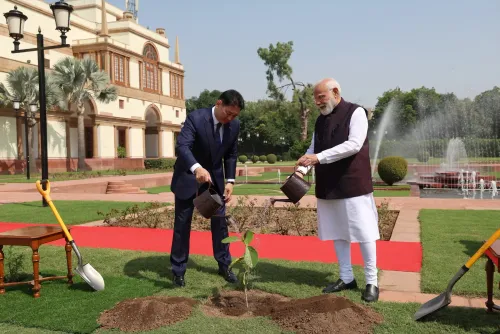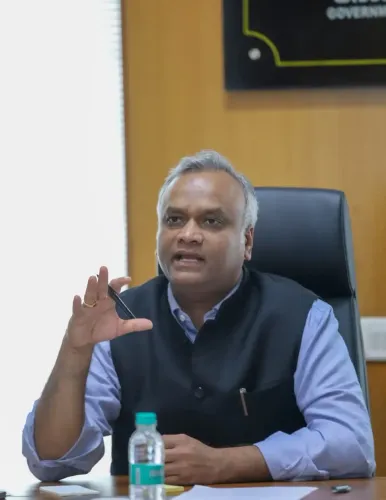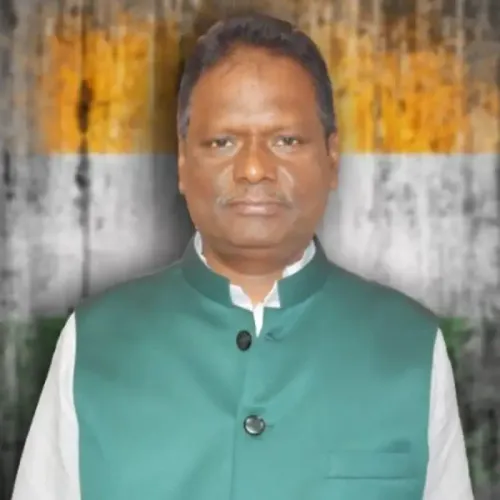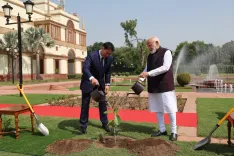Is India’s travel economy set to thrive at Rs 2.3 lakh crore?
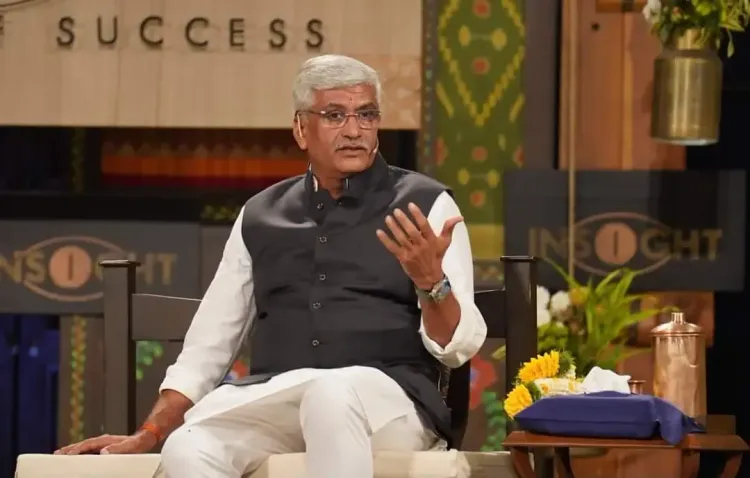
Synopsis
Key Takeaways
- India's tourism economy reached Rs 2.3 lakh crore in 2023.
- The country has climbed to 8th in global tourism rankings.
- Major events like Maha Kumbh 2025 will drive visitor engagement.
- Collaboration with platforms like Netflix aims to promote Indian destinations.
- Focus on improving infrastructure and local development is paramount.
Jaipur, Oct 14 (NationPress) India is rapidly establishing itself as a key player in the global tourism landscape, generating remarkable economic growth. With foreign exchange earnings hitting Rs 2.3 lakh crore in 2023 and climbing to 8th position in global tourism rankings, the nation is transforming its temples, towns, festivals, and natural landscapes into significant sources of revenue.
Supported by major events like Maha Kumbh 2025, partnerships with international platforms such as Netflix, and robust domestic initiatives like the 'Dekho Apna Desh' campaign, India is crafting an ambitious vision to elevate tourism as a primary contributor to its GDP.
Union Minister for Tourism Gajendra Singh Shekhawat shared in an exclusive interview with IANS: “India is no longer just a showcase of heritage; we are developing a world-class tourism economy.”
The strategy includes enhancing infrastructure, forming brand alliances, and restoring heritage sites, with the aim of positioning India among the world's top four tourism economies within the next ten years.
Interview Highlights:
IANS: Countries like the USA, France, Spain, and Italy generate substantial revenue from tourism. Is India pursuing a similar trajectory?
Gajendra Singh Shekhawat: Absolutely. India recognizes tourism as a vital economic catalyst. This year, we welcomed 9.52 million foreign visitors, yielding over Rs 2.3 lakh crore in foreign exchange. Our focus is on expanding this through improved infrastructure and enhanced visitor experiences. Initiatives like Swadesh Darshan 2.0 and PRASHAD are aimed at developing themed circuits and modern amenities at spiritual and cultural locations. Recently, the government approved 40 new projects worth Rs 3,295 crore to enhance lesser-known destinations under the SASCI scheme. Thus, the message is clear: tourism is not merely about showcasing India; it's about job creation, investment, and local development.
IANS: Following the monumental Maha Kumbh 2025, are there other significant events planned to highlight India’s cultural heritage?
Gajendra Singh Shekhawat: The Maha Kumbh 2025 was a historic event, attracting over 660 million visitors. However, our cultural calendar remains vibrant. Upcoming events include Odisha's Bali Yatra (November 5-12), honoring India’s maritime heritage; the Hornbill Festival in Nagaland (December 1-10), spotlighting the Northeast’s tribal richness; and the Kochi-Muziris Biennale (December 2025-March 2026), Asia’s largest contemporary art exhibition. These events keep the essence of India’s cultural diversity alive and draw global travelers.
IANS: What role will the Ministry of Tourism (MoT) and Netflix’s collaboration play in promoting Indian destinations?
Gajendra Singh Shekhawat: Films and series serve as excellent travel ambassadors. Our collaboration with Netflix will present Indian locales to a worldwide audience, from heritage cities to remote landscapes. The Ministry will facilitate the identification of filming locations, streamline permissions, and assist with logistics. The concept is straightforward: when viewers develop an affinity for a location on screen, they often wish to visit in person. Productions such as 'The Elephant Whisperers', 'Kaala Paani', and 'Amar Singh Chamkila' demonstrate how storytelling can drive tourism. This partnership amplifies that potential.
IANS: Domestic tourism is flourishing. How is the Ministry planning to promote it further?
Gajendra Singh Shekhawat: Domestic tourism is fundamental to our strategy. The “Dekho Apna Desh” initiative encourages Indians to explore their own nation. We are enhancing connectivity, infrastructure, and facilities through Swadesh Darshan 2.0 and upgrading the top 50 tourist destinations in collaboration with state governments. Additionally, we are supporting homestays through Mudra loans, investing in guide training, and recently reduced GST on hotel tariffs to make travel more affordable. Our aim is to create memorable, affordable, and accessible experiences for every Indian traveler.
IANS: India has advanced to 8th position in the WTTC’s global tourism rankings. What’s the next objective?
Gajendra Singh Shekhawat: Our aspirations are high—our target is to rank among the top four tourism economies globally within the next decade. The roadmap is defined: improved connectivity, cleaner destinations, effective branding, and seamless visitor experiences. Collaborations like Netflix enhance our global outreach, while initiatives like Swadesh Darshan 2.0 fortify our local framework. We envision India as a year-round destination where culture, wellness, nature, and adventure converge.
IANS: Is tourism in Rajasthan underperforming? Despite its incredible tourism assets, why does it attract fewer foreign tourists than expected, and what measures are being implemented?
Gajendra Singh Shekhawat: Rajasthan is indeed a gem, yet foreign arrivals are not reaching their potential. Factors such as limited direct flights, high travel costs, and inconsistent promotion are significant hurdles. We are collaborating with the state to address these issues—enhancing international connectivity, improving amenities, and focusing on overseas marketing. Additionally, there’s an initiative to transform Shekhawati’s havelis into heritage accommodations. Once we enhance infrastructure and storytelling, Rajasthan’s international visitor numbers will align with its true potential.
IANS: In a global context, while the USA leads in tourism revenue, France excels in visitor numbers. What lessons can India learn from these countries?
Gajendra Singh Shekhawat: Three key takeaways: First, world-class infrastructure encompassing airports, roads, and digital access. Second, robust branding akin to France’s Atout France, which markets seamlessly worldwide. Third, a diverse range of experiences—culture, gastronomy, business, nature, and wellness—all managed professionally. India possesses the foundational elements; we are now refining our offerings to compete with the best globally.

